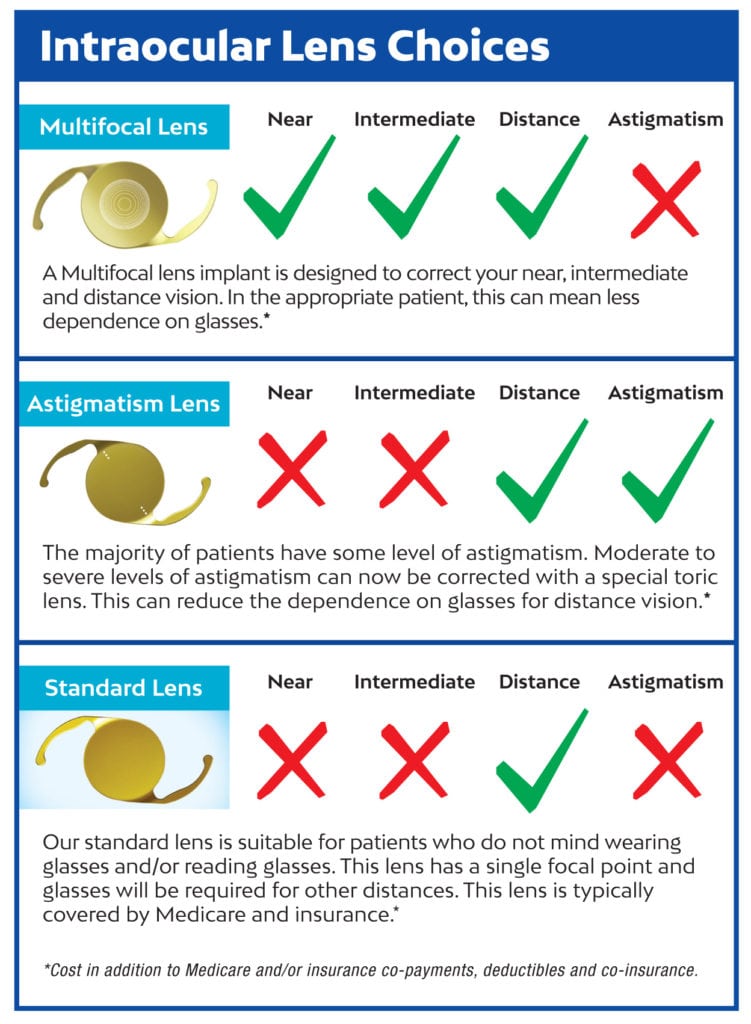Specialty Intraocular Lenses Can Reduce Your Dependence on Glasses
If it is time for you to have cataract surgery, we offer a host of the latest advancements in lens implants and surgical procedure options, including laser cataract surgery, to create a custom experience for you.
Years ago if you had cataract surgery, the natural cloudy lens was removed and there was nothing to replace it. People had to wear very thick eyeglasses or special contact lenses to be able to see clearly after cataract surgery. Now, we have a replacement for the eye’s natural lenses called intraocular lenses (IOLs). There are several types of lens implants available to help reduce or eliminate your dependence on glasses.
So why do some people still require glasses after their surgery while others do not? There are many factors that determine if you will continue to wear full time glasses, part time glasses such as reading glasses, or none at all. These factors include the overall health of the eye, the amount of astigmatism, your current eyeglass prescription and your visual needs.
 Patients who have cataract surgery with a monofocal IOL may need glasses for some or all distances. Monofocal IOLs have been used for several decades and are set to provide your best uncorrected vision at one focal point. Many people who choose a monofocal IOL have it set it for distance vision and use reading glasses for near activities. On the other hand, a person whose IOLs are set to correct near vision would need glasses to see distant objects clearly.
Patients who have cataract surgery with a monofocal IOL may need glasses for some or all distances. Monofocal IOLs have been used for several decades and are set to provide your best uncorrected vision at one focal point. Many people who choose a monofocal IOL have it set it for distance vision and use reading glasses for near activities. On the other hand, a person whose IOLs are set to correct near vision would need glasses to see distant objects clearly.
Monofocal IOLs can also be set for monovision, which is distance vision in one eye and near vision in the other eye. If you are considering monovision, your ophthalmologist may suggest trying this technique with contact lenses first to see how well you can adapt. If you require crisp, detailed vision, monovision may not be the best approach for you.
Astigmatism is an imperfection in the curvature of your cornea. Astigmatism correcting IOLs can also be used to help decrease the dependence upon glasses. These IOLs are monofocal IOLs that correct astigmatism so you can see without glasses at one distance. You may still rely on glasses for some activities.
Multifocal IOLs utilize advanced technology and offer a series of focal zones or rings built into the IOL. Depending on where light focuses through the zones, you may be able to see distance, intermediate and near objects clearly. The ability to read and perform other tasks without glasses varies from person to person but it is generally best when multifocal IOLs are placed in both eyes.
Regardless of the type of lens you select, you may still need to rely on glasses some of the time, but if correctly selected, your IOLs can greatly reduce your dependence on glasses. Discuss your options with your ophthalmologist to determine the IOL that best suits your vision needs and lifestyle.

 ANNOUNCING UPDATES TO OUR COVID-19 SAFETY PROTOCOLS
ANNOUNCING UPDATES TO OUR COVID-19 SAFETY PROTOCOLS